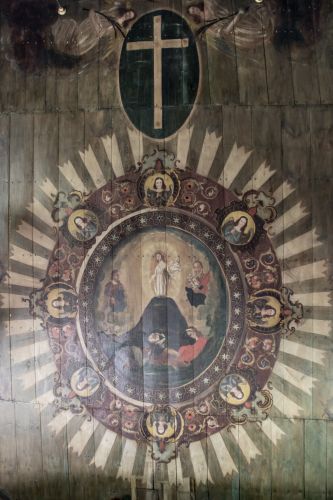
Monuments
Arma Christi
The central depiction in the church of the Cross in Września-Lipówka is a painting “The Crucifixion” which it thought to have been made in 1641. The main figures are Crucified Christ, the Mother of God and St. John. There is a panorama of an unidentified city, an advancing army and a small figure of a kneeling priest in a surplice. It is probably the founder of the chapel, Stanisław Bielawski, the rector of Września from 1627 – 1648.
In the main altar’s antependium there is a unique painting depicting Arma Christi, i.e. the Instruments of the Passion. They include:
- the veil with the image of nailed feet and hands with a burning heart in front of the cross,
- nails, the crown of thorn, INRI inscription, the hammer and pincers, the whip and the birch for flagellation,
- the lantern (people of the high priest were looking for Christ with lanterns in the Gethsemane), the gauntlet (a motif from “Lenten Lamentations” which mention a soldier who was beating the Savior in the face),
- the money bag (Judas betrayed Christ for thirty pieces of silver), the scarlet robe (the color of martyrdom), the vessel, the chain, the dice (soldiers cast lots for the Lord’s robes), the sponge on the reed (a sponge was soaked, with vinegar and given to Christ), the lance (it pierced Christ’s side), the ladder (the symbol of removal of Jesus’ body from the cross), the column (by which Christ was whipped).

An escape from the plague
The erection of the church in Lipka is connected with a miraculous spring. The tradition of healings attributed to it is emphasized by the pictures of saints in the church: Rosalia and Roch who guarded from the plague and infectious diseases.

St. Roch lived in the 13th-14th century and was born in Languedoc. As his mother prayed for a child, he was born with a cross-shaped birthmark on his chest. He gave all his money he inherited to the poor and he helped in a hospital in Rome. He became famous during his lifetime due to miraculous healing; however, he fell sick with the plague himself. When he returned to Languedoc, he was considered a spy and captured. Probably his jealous uncle was behind it. Roch died after being captured and put to jail and he was recognized by the local people thanks to the birthmark. On the body there was a piece of paper which said that those who asked St. Roch for help in the time of plague would be healed. St. Roch is the guardian of the sick, hospitals, prisoners and is called especially during plague.
A PRAYER TO ST. ROCH
O Great St. Roch, deliver us,
we beseech thee,
from the scourges of God;
through thy Intercessory,
preserve our bodies from contagious diseases,
and our souls from the contagion of sin.
Obtain for us salubrious air;
but, above all, purity of heart.
Assist us to make good use of health,
to bear suffering with patience;
and, after thy example,
to live in the practice of penance and charity,
that we may one day enjoy the happiness
which thou has merited by thy virtues.
St. Rosalia was a virgin and a hermit who lived in the 12th century in Palermo. She was born in a wealthy family where she grew up in Christian faith. Her name Rosalia got her closer to God – rosa means love to fellow men and to God, and lilly stands for purity and devotion to God. The saint declined the proposition of marriage to a young man from a rich family and she escaped to a cave near to Palermo, where she led a hermit’s life, full of prayers and mortification. She died at thirty-one.

Lord's transfiguration
Polychromy, multi-colored paintings which decorate walls, roofs or vaults, are one of the most common decorations of churches’ interiors. The interior of the church in Lipówka is decorated with polychromy from the second half of the 19th century. Elements of architecture such as cornices, pilasters with marbleizing and a pedestal were painted on wooden planks – they imitated ornaments of brick buildings. Intense blue color dominates and fills spaces between painted bright pilasters. The central scene of the roof painting is the scene of Lord’s Transfiguartion. The paintings were made in the third quarter of the 18th century in the folk baroque style.

“After six days Jesus took Peter, James and John with him and led them up a high mountain, where they were all alone. There he was transfigured before them. His clothes became dazzling white, whiter than anyone in the world could bleach them. And there appeared before them Elijah and Moses, who were talking with Jesus.Peter said to Jesus, “Rabbi, it is good for us to be here. Let us put up three shelters—one for you, one for Moses and one for Elijah.” (He did not know what to say, they were so frightened.) Then a cloud appeared and covered them, and a voice came from the cloud: “This is my Son, whom I love. Listen to him!” Suddenly, when they looked around, they no longer saw anyone with them except Jesus”
(Mark 9, 2-9)
Under the wall panelling during conservation works, older polychromy was found (depicting consecration, apostle, crosses usually put in twelve spots anointed by a bishop during devotement or consecration of a church, under which candlesticks or lamps were placed) as well as fragments of borders (an ornamental, draped fabric) which decorated the chancel’s walls.


